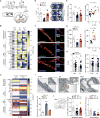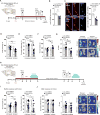Social stress induces neurovascular pathology promoting depression
- PMID: 29184215
- PMCID: PMC5726568
- DOI: 10.1038/s41593-017-0010-3
Social stress induces neurovascular pathology promoting depression
Abstract
Studies suggest that heightened peripheral inflammation contributes to the pathogenesis of major depressive disorder. We investigated the effect of chronic social defeat stress, a mouse model of depression, on blood-brain barrier (BBB) permeability and infiltration of peripheral immune signals. We found reduced expression of the endothelial cell tight junction protein claudin-5 (Cldn5) and abnormal blood vessel morphology in nucleus accumbens (NAc) of stress-susceptible but not resilient mice. CLDN5 expression was also decreased in NAc of depressed patients. Cldn5 downregulation was sufficient to induce depression-like behaviors following subthreshold social stress whereas chronic antidepressant treatment rescued Cldn5 loss and promoted resilience. Reduced BBB integrity in NAc of stress-susceptible or mice injected with adeno-associated virus expressing shRNA against Cldn5 caused infiltration of the peripheral cytokine interleukin-6 (IL-6) into brain parenchyma and subsequent expression of depression-like behaviors. These findings suggest that chronic social stress alters BBB integrity through loss of tight junction protein Cldn5, promoting peripheral IL-6 passage across the BBB and depression.
Figures




Comment in
-
An opening for humor in melancholy.Nat Neurosci. 2017 Dec;20(12):1657-1658. doi: 10.1038/s41593-017-0015-y. Nat Neurosci. 2017. PMID: 29184205 No abstract available.
References
MeSH terms
Substances
Grants and funding
LinkOut - more resources
Full Text Sources
Other Literature Sources
Medical
Molecular Biology Databases

